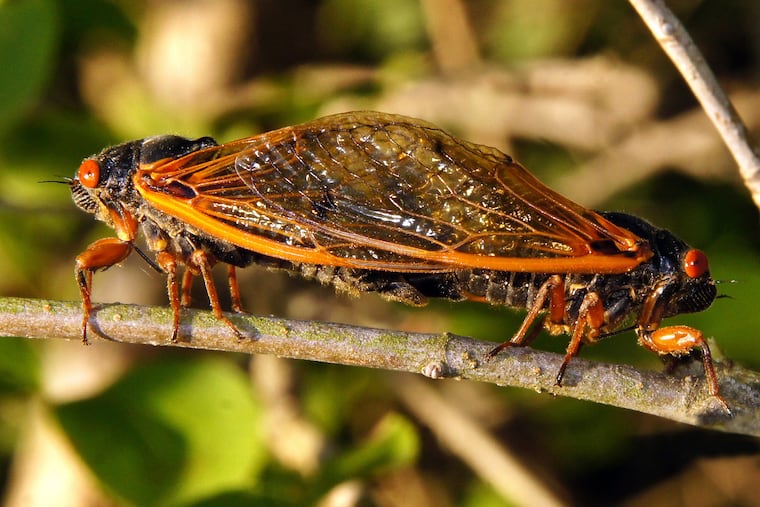Philly likely to miss out on the Brood X cicada hype, but Chester, Bucks Counties could catch the buzz
This spring, millions of noisy cicadas will emerge from 17 years underground, just as millions of spotted lanternflies hatch. It could be a hopping loud spring.

There’s been a lot of breathless media coverage of the Brood X cicadas that are set to emerge by the millions after 17 years underground, with the males creating an almost deafening incessant buzz from dawn to dusk — a heck of a way to attract a mate.
But if you live in Philly, Delaware County, and even most of South Jersey, you might end up wondering what all the hype is about.
Entomologists say that though there might be local pockets of cicadas emerging, most area residents won’t get to experience the massive collective mating calls some have described as the whir of a 1950s sci-fi spaceship.
The Brood X cicadas (that X denotes roman numeral 10) are among two big periodical broods of the insects that emerge every 17 years in this region. The other, Brood II, won’t emerge until 2030. Brood X is due to emerge in late May or early June and die off within five weeks.
The adult cicadas, about 1-5/8 inches long, are not harmful to humans or animals, nor especially destructive to plants. They can strip foliage but not to an extent that severely damages most trees. They are often mistakenly thought to be locusts
Jon Gelhaus, curator of entomology at the Academy of Natural Sciences of Drexel University, said records don’t show the brood has been a real presence in Philly in the past. In fact, the Academy’s collection, dating back to 1860, doesn’t have one Brood X specimen collected from the city among its four million specimens representing 100,000 species worldwide.
“We have periodical cicadas from elsewhere but none from Philadelphia,” said Gelhaus, also a professor at Drexel.
Further, a map produced by the University of Connecticut doesn’t show a large presence in the area, nor does one from the USDA Forest Service Northern Research Station.
Gelhaus said that doesn’t mean there won’t be any Brood X cicadas near Philly, but probably not like the presence elsewhere.
“Brood X is a widespread brood,” Gelhaus said. “But ... in the Philadelphia region it’s spotty. They’re not everywhere. Unless you happen to be where a population is emerging, you’d have to go find them.”
He recalls driving around Washington, D.C., in 2004 the last time the brood emerged and saw them “buzzing across I-95 into Maryland.” Not so much in Philly.
But the brood has been present in the past in the northern and western suburbs of Philadelphia and into the Lehigh Valley.
Specimens of Brood X have been collected in Downingtown, Perkiomenville, Spring Mount, Lower Frederick Township, Quakertown, and Lake Nockamixon State Park in Pennsylvania; and in Franklinville and especially Princeton in New Jersey.
Gelhaus cautions people not to confuse the periodical Brood X with the annual emergence of other cicada species, which come later in the summer. Brood X will die off before those yearly cicadas emerge.
Brood X cicadas have black bodies with reddish legs and eyes, and orange, nearly transparent wings. Annual cicadas, usually green or brown bodies, make different noises. They emerge in early July and through the summer after the Brood X has died off.
You’ll know you might have Brood X present if you see mud chimneys on your lawn the cicadas build before they emerge.
Even if Brood X was present in an area 17 years ago, it might not reemerge now. The insects thrive underground by feeding on the sap of tree roots. If the trees are torn down, they cannot survive.
Rutgers entomologist George C. Hamilton said the Princeton area and the parks surrounding it might be among the best places to experience cicadas in New Jersey.
“We’ve had some emergence in the southern part of the state,” Hamilton said, “but I didn’t hear to any large extent from my fellow entomologists in the southern part of the state. It was mostly an issue in Morris County ... and Princeton.”
Hamilton said he can almost guarantee a large population in Princeton and it is best to go out in the late afternoon to witness the juveniles emerge from the ground, climbing onto trees and shedding their skin. He plans to take graduate students out.
“It’s fascinating, but maybe only for entomologists,” Hamilton added.
He said people should not try to kill the cicadas by spraying insecticides. Just as many will reappear the next day so the task would be futile.
Hamilton cautions that the insects can damage orchards, or sensitive plants in residential areas, such as rhododendrons. In those cases, he advises covering plants with burlap.
He said trees are injured when the females use a tubelike organ to insert their eggs in twigs. It causes the twigs to die to the tip of the branch, causing leaves to turn brown and the branch tip to break. In most instances, he said, it amounts to a “natural pruning.”
After the adults have died, the eggs start to emerge by the end of July or beginning of August, drop to the ground, and are set to wait another 17 years before emerging.